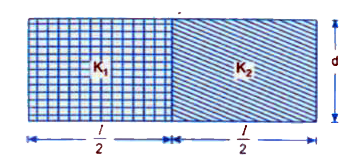Figure shows two identical capacitors C1andC2 each of 2μF capacitance, connected to a battery of 5 V. Initially switch 'S' is closed. After some time 'S' is left open and dielectric slavs of dielectric constant K = 5 are inserted to fill completely the space between the plates of the two capacitors. How will the (i) charge and (ii) potential difference between the plates of the capacitors be affected after the slabs are inserted?

(i) When S is open charge on each capacitor will be
q1=C1Vq2=C2'Vq1=5CV=5×2×5=50μCq2=50μC0−6×2
(ii) P.d. across C1 is still 5V and across C2,q=(5C)V
V'=V5=55=1V.
Topper's Solved these Questions
- XII BOARDSBook:XII BOARDS PREVIOUS YEARChapter:XII BOARDSExercise:SET-III, DELHI BOARD
Explore 8 Videos
- XII BOARDSBook:XII BOARDS PREVIOUS YEARChapter:XII BOARDSExercise:[Set- II]
Explore 8 Videos
- XII BOARDSBook:XII BOARDS PREVIOUS YEARChapter:XII BOARDSExercise:PHYSICS (Theory) [SET -I]
Explore 33 Videos
- SAMPLE PAPER 2019Book:XII BOARDS PREVIOUS YEARChapter:SAMPLE PAPER 2019Exercise:SECTION D
Explore 6 Videos
Similar Questions
Figure shows two identical caoacitors C1andC2 each of 1.5μF caoacitance, connected to a battery of 2 V. Initially switch 'S' is closed. After some time 's' is left open and dielectric slabs of dielectric constant K=2 are inserted to fill completely the space between the plates of the two capacitors. How will the (i) charge and (ii) potential difference between the plates of the capacitors be affected after the slabs are inserted.

View SolutionFigure shows two idential capacitors, C1andC2, each of 1μF capacitance connected to a battery of 6 V. Initially switch 'S' is closed. After sometime 'S' is left open and dielectric slabs of dielectric constant K = 3 are inserted to fill completely the space between the plates of the two capacitors. How will the (i) charge and (ii) potential difference between the plates of the capacitors be affected after the slabs are inserted?

View Solution
Knowledge Check
When dielectric is inserted in the space between plates of a capacitor, then
Amagnitude of charge increases.Bmagnitude of charge decreases.Ccharge remains the same.Dcharge becomes zero.When a dielectric is inserted in the space between parallel plates of a charged capacitor, then
Ainduced charges of opposite signs appear on each surface of dielectricBinduced charges of same sign appear on each surface of dielectric.Cinduced e.m.f. is generated between plates.Dmigration of electrons stop.A capacitor plates are charged by a battery with ‘V’ volts. After charging battery is disconnected and a dielectric slab with dielectric constant ‘K’ is inserted between its plates, the potential across the plates of a capacitor will become
AZeroBV2CVkDKV
Fig. shows two identical capacitors C1andC2 each of 1μF capacitance, connected to a battery of 6V Initially,swich S is closed. After sometime, S is left open and dielectric slabs of dielectric constant K = 3 are instered to fill compelelty the space between the plates of two capacitors. How will the (i) charge and (ii) potential difference between the plates of the capacitors be affected after teh slabs are inserted ?

View SolutionFig, shows two indentical capacitors C1andC2 each of 1μF capacitance connected to a battery of 6V. Inditally, swich S is closed. After some time, the swich S is left open and dielectric slabs of K = 3 are inserted to filll completely the space between the plates of two capacitors . How will (i) the charge and (ii) potential difference between the plates of the capacitors be affected after the slabs are inserted ?

View SolutionTwo dielectric slabs of dielectric constants K1andK2 are filled in between the two plates, each of area A, of the parallel plate capacitor as shown in the figure. Find the net capacitance of the capacitor.

View SolutionA capacitor plates are charged by a battery with ‘V’ volts. After charging battery is disconnected and a dielectric slab with dielectric constant ‘K’ is inserted between its plates, the potential across the plates of a capacitor will become
View SolutionA parallel plate capacitor is charged by a battery. After some time the battery is disconnected and a dielectric slab of dielectric constant K is inserted between the plates. How would (i) the capacitance, (ii) the electric field between the plates and (iii) the energy stored in the capacitor, be affected ? Justify your answer.
View Solution

